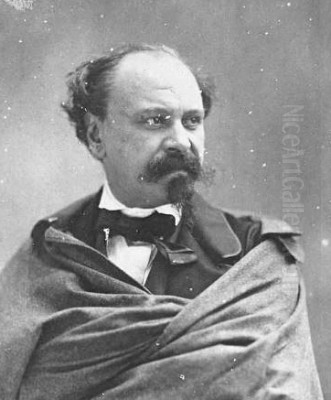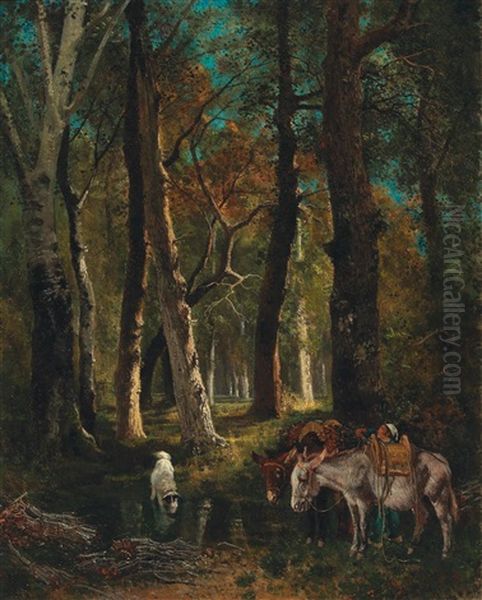
Giuseppe Palizzi stands as a significant figure in 19th-century Italian art, a painter whose career navigated the rich artistic traditions of Naples and the revolutionary movements unfolding in Paris. Born in Lanciano in the Abruzzo region of Italy on March 12, 1812, he was part of a remarkable family of artists who would leave a lasting mark on Italian painting. His family later moved to Vasto, another town in Abruzzo, which remained an important touchstone for the Palizzi brothers throughout their lives. Active primarily during the middle and later decades of the 19th century, Giuseppe Palizzi is best known for his evocative landscapes and sensitive depictions of animals, works that reflect a deep engagement with Realism and the influential Barbizon School.
His journey as an artist took him from the formal halls of the Neapolitan Academy to the forests surrounding Paris, making him a crucial conduit for transmitting the latest French artistic ideas back to Italy. He died in Passy, near Paris, on January 10, 1888, leaving behind a body of work celebrated for its naturalism, its handling of light, and its contribution to the broader movement of Realism in Europe.
Early Life and Neapolitan Foundations
Giuseppe Palizzi's artistic inclinations emerged early. He, along with his brothers Filippo, Nicola, and Francesco Paolo, grew up in an environment that seemingly encouraged artistic pursuits. Seeking formal training, Giuseppe enrolled in the Royal Academy of Fine Arts (Reale Accademia di Belle Arti) in Naples around 1835 or 1836. Naples at this time was a vibrant artistic center, home to the flourishing School of Posillipo, known for its picturesque landscape paintings that broke away from stricter Neoclassical conventions.
At the Academy, Giuseppe studied under figures associated with the Neapolitan establishment, including the landscape painter Gabriele Smargiassi. However, like many artists of his generation seeking a more direct engagement with reality, Palizzi reportedly grew dissatisfied with the rigid, academic methods taught there. The emphasis on drawing from casts and copying Old Masters felt limiting to an artist increasingly drawn to the direct observation of nature. This dissatisfaction spurred him to leave the Academy after a relatively short period, likely around 1837 or 1838.

Freed from academic constraints, Giuseppe began to explore a more naturalistic approach. He looked towards the legacy of the School of Posillipo, whose artists like Antonie Sminck Pitloo and Giacinto Gigante emphasized outdoor sketching and capturing the specific light and atmosphere of the Neapolitan landscape. He also began focusing intently on the study of animals, a theme that would become central to his work and that of his famous brother, Filippo Palizzi. This early period in Naples laid the groundwork for his later development, instilling in him a love for landscape and a commitment to truthful representation.
The Journey to France: Embracing Barbizon
A pivotal moment in Giuseppe Palizzi's career was his decision to move to France. Around 1844, seeking broader artistic horizons and likely drawn by the burgeoning landscape painting movement, he settled near Paris. This move proved transformative, immersing him in the heart of artistic innovation. He gravitated towards the village of Barbizon, situated near the Forest of Fontainebleau, which had become a gathering place for a group of painters dedicated to a new, unvarnished approach to landscape.
These artists, collectively known as the Barbizon School, rejected the idealized, historical landscapes favored by the Academy. Instead, they advocated for painting directly from nature (en plein air sketching, though final works were often completed in the studio), capturing the specific moods, light conditions, and textures of the rural environment. Key figures included Jean-Baptiste-Camille Corot, known for his silvery light and poetic atmospheres; Théodore Rousseau, a meticulous observer of trees and forest structures; Jean-François Millet, who depicted the dignity of peasant life; and Charles-François Daubigny, who often painted tranquil river scenes from his studio boat. Others like Narcisse Diaz de la Peña also contributed to the school's focus on woodland interiors and atmospheric effects.
Giuseppe Palizzi deeply absorbed the lessons of Barbizon. He spent considerable time painting in the Forest of Fontainebleau, developing a particular affinity for depicting its ancient trees, dappled light, and woodland clearings. His style shifted, embracing a looser brushwork, a more nuanced color palette sensitive to atmospheric conditions, and a profound commitment to capturing the authentic character of the natural world. His works from this period often feature forest interiors, rural pathways, and scenes of country life, rendered with a realism tempered by a subtle romantic sensibility.
Realism, Animals, and the Dutch Legacy
Palizzi's time in France coincided with the rise of Realism, spearheaded by Gustave Courbet. While closely associated with the Barbizon painters, Courbet pushed for an even more direct, unidealized depiction of contemporary life and landscape, famously stating he could not paint an angel because he had never seen one. Palizzi's work shares affinities with this broader Realist ethos, particularly in its focus on humble, everyday subjects – peasants, farm animals, and unassuming corners of the countryside.
His depictions of animals became particularly noteworthy. Like his brother Filippo, Giuseppe possessed a keen ability to capture the anatomy, posture, and character of animals, especially sheep, cattle, donkeys, and dogs, often integrating them seamlessly into his landscape settings. This focus may have been reinforced by an interest in 17th-century Dutch Golden Age painting, which was admired by many Barbizon artists. Painters like Paulus Potter, known for his detailed animal portraits within landscapes, or landscape specialists like Jacob van Ruisdael and Meindert Hobbema, offered historical precedents for the realistic portrayal of nature and rural life.
Palizzi's approach, influenced by Barbizon and Realism, aimed for authenticity. He sought to convey the textures of bark, the play of light on foliage, the weight and presence of animals, grounding his scenes in careful observation. While Filippo Palizzi became renowned for almost scientifically precise studies of animals, Giuseppe often placed them within broader, more atmospheric landscape compositions, emphasizing the harmony between creature and environment.
Mature Style and International Recognition
Giuseppe Palizzi largely based himself in France for the remainder of his career, particularly favoring the area around Barbizon and Grez-sur-Loing, another village popular with artists near Fontainebleau. While he maintained connections with Italy and his family, his artistic identity became strongly linked to the French art scene. He regularly exhibited his works at the prestigious Paris Salon, gaining recognition among French critics and collectors.
His mature style solidified his reputation as a master of the woodland landscape and animal painting. Works like The Forest of Fontainebleau (various versions exist, one notable example dated 1874) exemplify his skill in capturing the grandeur and intimacy of the forest, using light and shadow to create depth and mood. He often depicted scenes featuring timber wagons, woodcutters, or grazing animals, integrating human or animal activity naturally within the dominant landscape.
His international standing was confirmed when he was awarded a gold medal at the Exposition Universelle (World's Fair) in Paris in 1867, a significant honor that acknowledged his contribution to contemporary landscape painting. This recognition placed him among the leading landscape artists of his time, respected both in his adopted country and, increasingly, back in Italy, where his success abroad reflected positively on the burgeoning national art scene following Italian unification. His paintings entered important collections, demonstrating the appeal of his truthful yet poetic vision of nature.
Interactions and Influence
Throughout his career, Giuseppe Palizzi interacted with a wide circle of artists. His closest artistic relationship was undoubtedly with his brothers, especially Filippo. While Giuseppe spent much of his time in France, the brothers exchanged ideas, and Giuseppe's direct experience with French Realism and the Barbizon School significantly influenced the direction of Filippo's work and, through him, the broader Neapolitan school towards Verismo (the Italian strand of Realism).
In France, he was part of the Barbizon community, interacting directly with figures like Corot, Rousseau, and possibly Millet and Daubigny. His work also shows an awareness of broader trends in French Realism, including the work of Courbet. Some later commentators have even noted thematic parallels, perhaps superficial, between certain Palizzi compositions and works by figures like Édouard Manet, though their stylistic approaches remained distinct. Manet himself was influenced by Realism but paved the way towards Impressionism.
Back in Italy, Palizzi's work was seen as an important example of modern European painting. He maintained contact with Neapolitan artists, potentially including figures associated with the later development of Verismo in Naples, such as Domenico Morelli, Saverio Altamura, or Bernardo Celentano, although these artists often focused more on historical or genre scenes with a Realist bent. His success in Paris provided a model for Italian artists seeking international recognition and demonstrated the vitality of landscape and animal painting executed with modern sensibilities. His connection to the earlier School of Posillipo (Pitloo, Gigante) also places him within a longer Neapolitan tradition of landscape innovation.
The Palizzi Legacy
Giuseppe Palizzi passed away in 1888, having spent much of his adult life interpreting the landscapes of France through an Italian lens, refined by the principles of the Barbizon School. His legacy is multifaceted. He was a key member of perhaps the most important family dynasty in 19th-century Italian art, contributing significantly to their collective reputation.
His most crucial role was arguably that of a cultural intermediary. By immersing himself in the French art world and adopting the techniques and philosophies of the Barbizon painters and Realists, he helped introduce these vital currents into Italian art. His influence, transmitted directly and through his brothers, encouraged a move away from academic formulas towards a more direct, observational, and truthful depiction of the natural world and rural life. This contributed to the development of Verismo in Naples and other regional schools of Italian Realism, such as the Macchiaioli in Tuscany (led by artists like Giovanni Fattori and Silvestro Lega), although the Macchiaioli developed their own distinct style focused on capturing light and form through patches ('macchie') of colour.
Today, Giuseppe Palizzi's works are held in major museum collections, primarily in Italy but also internationally. Important examples can be found at the Galleria Nazionale d'Arte Moderna in Rome, the Museo di Capodimonte and the Galleria d'Arte Moderna in Naples, the Pinacoteca di Brera and Galleria d'Arte Moderna (GAM) in Milan, and the Galleria d'arte moderna Ricci Oddi in Piacenza, among others. These paintings stand as testaments to his skill in capturing the nuances of light, the textures of nature, and the quiet dignity of rural landscapes and their animal inhabitants.
Conclusion: A Bridge Between Worlds
Giuseppe Palizzi occupies a unique and important position in the history of 19th-century European art. As an Italian artist who found his mature voice in the forests of Fontainebleau, he embodied the cross-cultural exchanges that revitalized painting during this era. His commitment to Realism, learned alongside the pioneers of the Barbizon School, allowed him to create landscapes and animal studies of remarkable sensitivity and authenticity. While perhaps sometimes overshadowed internationally by his French contemporaries or domestically by his prolific brother Filippo, Giuseppe's contribution was vital. He not only produced a compelling body of work in its own right but also served as a crucial bridge, bringing the innovations of French landscape painting to Italy and enriching the development of Italian Realism. His paintings continue to resonate today for their honest portrayal of nature and their masterful handling of light and atmosphere.